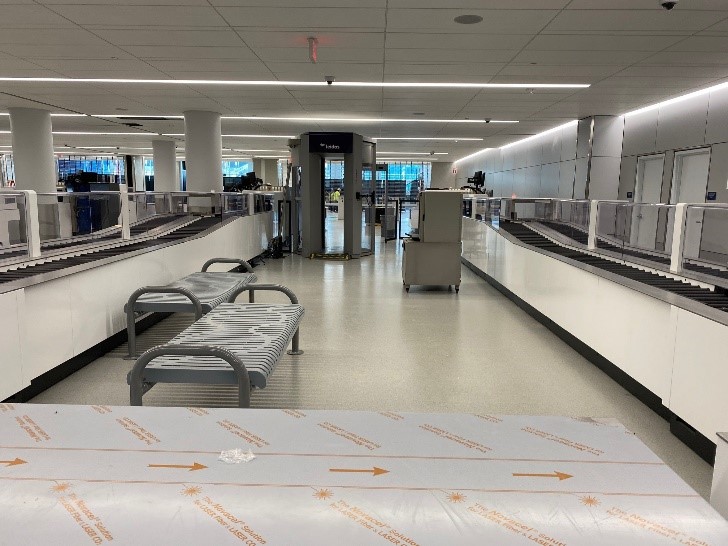Officials with Charlotte Douglas International Airport (CLT) and the Transportation Security Administration (TSA) have previewed the new security checkpoint in the airport terminal. Checkpoint 1, at the west end of the new terminal lobby, will feature eight lanes to screen departing travelers.
“We are thrilled to begin conducting security screening operations in Checkpoint 1,” said Beth Walker, TSA Federal Security Director at CLT, at the preview on October 20. “This new space provides TSA officers more room to carry out their security duties and the opportunity to work seamlessly and collaboratively across all eight lanes to best serve the traveling public. Thank you to the airport authority for investing in this new checkpoint that will help TSA deliver the highest level of security screening in the most efficient manner.”
CLT’s chief operating officer, Jerome Woodard, said, “The opening of Checkpoint 1 is a monumental achievement for the airport and will greatly enhance our ability to service the growing passenger traffic at CLT. The technology enhancements will provide for greater throughput in passenger screening, which allows for a more efficient checkpoint operation. Passengers can look forward to an improved screening experience due to the open design of the checkpoint, which incorporates some of the industry’s best practices in checkpoint design.”
The opening of Checkpoint 1 brings the total number of security screening lanes at the airport to a maximum of 21. TSA will continue to operate a four-lane C checkpoint dedicated to TSA PreCheck screening as well as the four-lane A checkpoint and five-lane E checkpoint. At CLT, all security checkpoints lead to all gates.
Construction on Checkpoint 1 began in March 2023 as part of a US$600m terminal lobby expansion project that began in 2019 to increase the current terminal lobby space by 16,258m2 and renovate another 17,745m2. The project is expected to be completed by autumn 2025.
Checkpoint 1 features expanded queuing space for travelers entering the checkpoint. There are also 16 travel document-checking podiums where TSA officers conduct identity verification. In addition, travelers will notice that the security checkpoint is a brighter, more open space, and will see familiar security technologies in use.
Credential authentication technology
Credential authentication technology (CAT) automates the identity verification process. When a TSA officer (TSO) scans the traveler’s government-issued photo ID, the CAT unit verifies its validity and confirms that the individual is ticketed for travel, using a secure internet connection. The TSO is also given on-screen prompts about the type of screening for which the traveler is eligible (such as standard or TSA PreCheck), without the need for the traveler to present a boarding pass.
CAT also plays an important role in travel document verification. It improves a TSO’s ability to authenticate a photo ID while also detecting counterfeit or fraudulent ID. A CAT unit can read several hundred types of photo ID including US and foreign passports, and state- or territory-issued driver licenses and identification cards.
Automatic screening lanes
Checkpoint 1 features six automated screening lanes (ASLs) that are designed to improve passenger screening by automating many of the checkpoint functions that were previously performed manually. The advanced screening system allows travelers to move more quickly and efficiently through the security checkpoints. The ASL technology includes:
- Individual, side-by-side, stainless-steel stations that enable four travelers to place their carry-on property in bins; all carry-on property must be placed in a bin;
- Bins that are 25% larger than standard screening lanes bins; they are large enough to hold larger carry-on bags;
- Automated conveyor belts that populate bins for travelers to use and subsequently return the bins from the back of the checkpoint to the front;
- Automatic diversion of carry-on property that may contain a potential security threat, allowing bins behind to continue through the screening process uninterrupted;
- Radio frequency identification (RFID) tags are attached to each bin to allow for additional accountability of a traveler’s carry-on property as they transit throughout the security process.
There are two non-ASL lanes at the right end of the checkpoint to screen oversize items and those that require special attention.
Passenger screening technologies
Checkpoint 1 is outfitted with four body scanners and four walk-through metal detectors to screen individual travelers. Body scanners use a harmless electromagnetic wave to scan the passenger to detect metallic or non-metallic objects that may be concealed in layers of clothing or on the body. They are equipped with software that creates a standardized, computer-generated image that is the same for every traveler. If the body scanner detects a potential security threat, a yellow box appears on the generic image on-screen, which identifies where the TSO needs to conduct any follow-up screening.
Because the body scanner is not a metal detector, many travelers, including those with metal hips or knee replacements, prefer to be screened by it. In addition, the body scanner does not use x-ray technology or generate specific x-ray images of any traveler.
Bottle liquid scanner
TSA allows travelers to bring medically necessary liquids in carry-on luggage in quantities larger than 100ml. To ensure that these items do not pose a security threat, TSA’s liquid explosive detection system uses lasers to measure the density of the liquid without having to open the container. This type of screening takes seconds and can be used to screen liquids and gels.
Explosive trace detection
TSOs may conduct explosive trace detection (ETD) screening that involves swabbing a traveler’s hands or their belongings at the security checkpoint. The swab is inserted into a specially programmed ETD unit that can detect tiny amounts of explosive residue. TSA has a process in place to resolve any alarms related to the detection of explosive residue.
TSA at CLT screened more than 8.1 million departing travelers in the first nine months of 2023, an 18% increase over the same period in 2022, and 12% over pre-pandemic volumes. TSA expects to begin screening departing travelers at Checkpoint 1 on Sunday, November 5.
For more on security, please click here.

